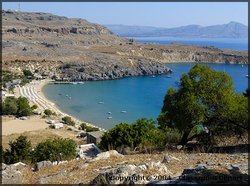Adriatic Sea
|
|
The Adriatic Sea is an arm of the Mediterranean Sea separating the Apennine peninsula (Italy) from the Balkan peninsula, and the system of the Apennine Mountains from that of the Dinaric Alps and adjacent ranges.
The western coast is Italian, while the eastern coast runs along the countries of Slovenia, Croatia, Bosnia and Herzegovina, Serbia and Montenegro, and Albania.
| Contents |
Name and etymology
Adriatic_Sea_map.png
The name has existed since the antiquity; in Latin it was Mare Hadriaticum. In modern languages, it is Mare Adriatico in Italian, Jadransko morje in Slovenian, and Jadransko more in Croatian, Serbian and Bosnian.
The name, derived from the town of Adria (or Hadria), belonged originally only to the upper portion of the sea (Herodotus vi. 127, vii. 20, ix. 92; Euripides, Hippolytus, 736), but was gradually extended as the Syracusan colonies gained in importance.
But even then the Adriatic in the narrower sense only extended as far as the Mons Garganus, the outer portion being called the Ionian Sea: the name was sometimes, however, inaccurately used to include the Gulf of Tarentum (the modern-day Gulf of Taranto), the Sea of Sicily, the Gulf of Corinth and even the sea between Crete and Malta (Acts xxvii. 27).
Extent
The Adriatic extends northwest from 40? to 45? 45' N., with an extreme length of about 480 miles (770 km). It has a mean breadth of about 100 miles (160 km), although the Strait of Otranto, through which it connects at the south with the Ionian Sea, is only 45 miles (72 km) wide.
Moreover, the chain of islands which fringes the northern part of the eastern shore reduces the extreme breadth of open sea in this part to 90 miles. Its total surface area is about 60,000 square miles (160,000 km²).
The northern part of the sea is very shallow, and between the southern promontories of Istria and Rimini the depth rarely exceeds 25 fathoms (46 m). Between Šibenik and Ortona a well-marked depression occurs, a considerable area of which exceeds 100 fathoms (180 m) in depth.
From a point between Korčula and the north shore of the spur of Monte Gargano there is a ridge giving shallower water, and a broken chain of a few islets extends across the sea.
The deepest part of the sea lies east of Monte Gargano, south of Dubrovnik, and west of [[Durr볝] where a large basin gives depths of 500 fathoms (900 m) and upwards, and a small area in the south of this basin falls below 800 (1,460 m). The mean depth of the sea is estimated at 133 fathoms (240 m).
Coasts and islands
The west shore is generally low, merging, in the northwest, into the marshes and lagoons on either hand of the protruding delta of the river Po, the sediment of which has pushed forward the coastline for several miles within historic times -- Adria is now some distance from the shore.
On islands within one of the lagoons opening from the Gulf of Venice, Venice has its unique situation. Other notable cities on the Italian coast are Ravenna, Rimini, Ancona, Bari, and Pescara.
The east coast is generally bold and rocky, with many islands. South of the Istrian Peninsula, which separates the Gulfs of Venice and Gulf of Trieste from the Bay of Kvarner, the island-fringe of the east coast extends as far south as Dubrovnik.
The islands, which are long and narrow (the long axis lying parallel with the coast of the mainland), rise rather abruptly to elevations of a few hundred feet, with the exception of a few larger islands like Brač (Vidova gora, 778 m) or the peninsula Pelješac (St. Ilija, 961 m). There are over a thousand islands in the Adriatic, 66 of which are inhabited.
On the mainland, notably in the magnificent inlet of the Boka Kotorska (Bocche di Cattaro) (named after the town of Kotor), lofty mountains often fall directly to the sea.
The prevalent colour of the rocks is a light, dead grey, contrasting harshly with the dark vegetation, which on some of the islands is luxuriant. In fact, Montenegro (Black Mountain) was named after the black pines that cover the coast there, and similarly the Greek name for the island of Korcula is Korkyra Melaina meaning "Black Corfu".
Major cities on the northeastern coast include Trieste in Italy; Izola, Koper, Piran and Portorož in Slovenia; Pula, Rovinj, Rijeka, Zadar, Šibenik, Trogir, Split, Dubrovnik in Croatia; Herceg Novi, Bar, Ulcinj in Serbia and Montenegro; and [[Durr볝] in Albania.
Miscellaneous
The bora or bura (northeast wind), and the prevalence of sudden squalls from this quarter or the southeast, are dangers to navigation in winter. Also notable are sirocco or jugo (southern wind) which brings rain in the winter and maestral (western wind) which brings nice weather in the summer.
Tidal movement is slight. The amphidromic point is just off the northwestern shore, near Ancona.
Both coasts are popular tourist destinations.

